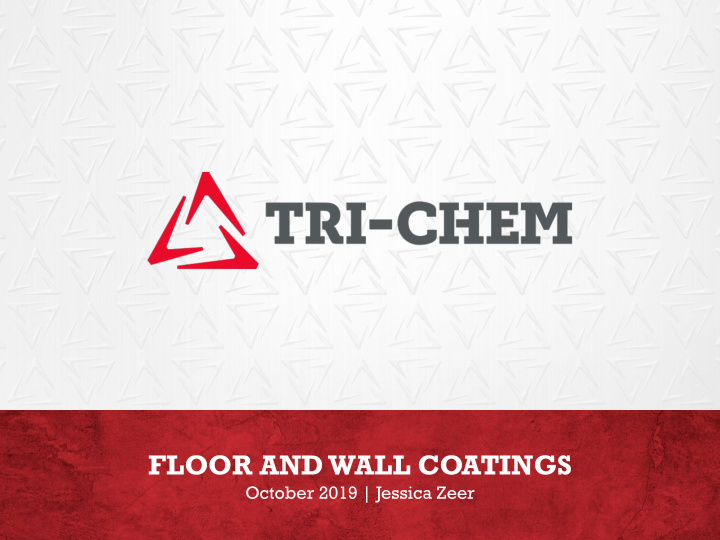



FLOOR AND WALL COATINGS October 2019 | Jessica Zeer
WHY COATINGS FAIL Poor surface Excessive moisture/ 73 % 18 % preparations/ contaminant transmission insufficient bond profile Test the moisture • vapor emission rate • Do not cut corners Use moisture • Coating will fail no • mitigation system if matter how great it is necessary Poor installation/ Job site conditions 5 % 4 % contractor error • Excessive air movement • Not enough material Inadequate lighting • thickness Inadequate • Improperly mixed • surface/air material temperature Materials too hot or cold • Moisture/pedestrian • • Find properly trained trade interference contractor
SURFACE PREPARATION Surface prep is key! • 73% of all coating failures are a result of insufficient surface preparation. Remove all existing coatings • (depending on the product type) Coatings can be removed with • stripping chemicals, shot blasting, sanding, diamond grinding, and acid etching Without proper preparation, even • great materials will not hold up • A proper preparation will result in a strong mechanical bond to the substrate
DO IT YOURSELF Advantages : • Reduce your cost up to 50% Work within your own timelines • • As many sq. ft. at a time as desired Use a product that is: VOC free • • Dummy-proof Self-leveling • Easy to work with • • Pre-measured
IF USING AN INSTALLER Make sure they check the following boxes: • Experience with the required flooring system Proper surface prep equipment • • Excellent safety record Ability to understand challenges • working in occupied correctional facilities Proper liability insurance • Do they manufacture the product? • • Who offers the warranty?
SUBSTRATES THAT CAN BE COATED BEFORE Just about any vertical or horizontal substrate! • Concrete VCT • Tile and Grout • Terrazzo • • Metal • Wood Epoxy • Fiberglass/Plastic • Foam/Stucco • AFTER • Vinyl Sheeting • Dry Wall Brick • Previously Painted Surfaces •
PROBLEM AREAS IN CORRECTIONS BEFORE Food Service Area • Kettle areas Dish tray room • Wash down area • Coolers and freezers • • Loading docks Showers Chipping grout • • Broken tiles AFTER • Hard-to-clean surfaces creating mold and mildew Uncoated block or concrete • Slip hazards •
COATING ADDITIVES Non-Slip Additives Non-slip additives can be added to • coatings to increase the co-efficient of friction (slip resistant) • Recommended for wet areas Accelerators • Accelerators can be added to help reduce the drying time Recommended for environments that • can’t afford much facility downtime Adhesion Bonds Adhesion Bonds can be added to • provide excellent adhesion properties to hard-to-adhere surfaces • Recommended for ceramic, porcelain, quarry and other tile and grout surfaces.
MAINTAINING COATINGS • Proper cleaning increases and maintains the life of coatings Cleaning coatings ensures proper • sanitary conditions Some VCT coatings can eliminate • the need to ever wax again and provide easy maintenance with less downtime Keeps employee safety a priority • where slip and fall conditions are a concern • Vertical surfaces can be cleaned by power washing or steam cleaning
PROPERLY COATED SURFACES
PROPERLY COATED SURFACES BEFORE AFTER
PROPERLY COATED SURFACES
PROPERLY COATED SURFACES
PROPERLY COATED SURFACES
PROPERLY COATED SURFACES Eliminates the need to wax VCT with a gloss that lasts 3-5 year
JESSICA ZEER MIKE LENK Account Manager Director of Industrial Flooring 248.583.0184 x256 248.583.0184 x275 jzeer@tri-chem.com mlenk@tri-chem.com
Recommend
More recommend